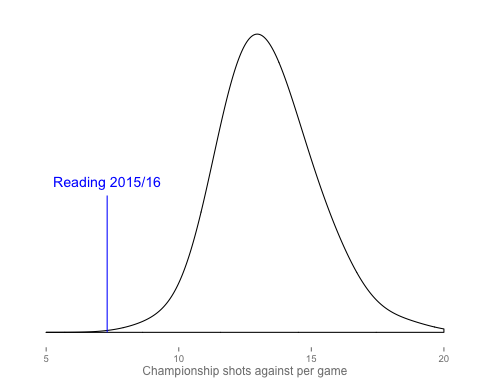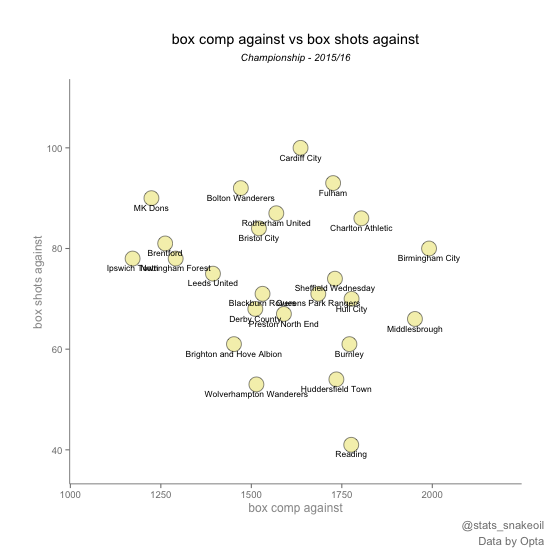With all this talk about crises, coefficients, Kloppomania and various balanced pieces on the increasing role of analytics and air-conditioning in modern football, you could be forgiven for forgetting about England's second tier. However, a little further away form the media spotlight (unless you're the most vocal advocates of analytics sacking your manager, in which case...), the Championship has been chugging along just fine. Blue Boys One team this season has conceded far fewer shots than the rest and it’s not even close. 
 So, uh, pretty good, right? And it’s not like this is versus weak teams, either. They’ve taken on Middlesbrough, Derby, Ipswich and Burnley, winning all of those but one (1-0 to Derby County). Can they keep it up? Well, this lack of shots so far looks to be driven by high defensive efficiency; they are conceding far fewer shots than they are allowing completed passes. In other words, the data suggests they are stopping opponents from shooting, as opposed to stopping them from entering the final third of the pitch (a definition for 'deep completions' used here is outlined at the bottom of the article):
So, uh, pretty good, right? And it’s not like this is versus weak teams, either. They’ve taken on Middlesbrough, Derby, Ipswich and Burnley, winning all of those but one (1-0 to Derby County). Can they keep it up? Well, this lack of shots so far looks to be driven by high defensive efficiency; they are conceding far fewer shots than they are allowing completed passes. In other words, the data suggests they are stopping opponents from shooting, as opposed to stopping them from entering the final third of the pitch (a definition for 'deep completions' used here is outlined at the bottom of the article):  Clearly Reading are an outlier here, and their suppression of opponents' shots isn't driven by domination of territory. So are they lucky? Is it their system? Both? These are questions I'm reluctant to give definitive answers to without consulting more video evidence (sorry). However, we can reframe the question slightly to make it more testable: Do teams maintain extreme performances in this type of defensive 'efficiency' (i.e. is Defensive box efficiency over the first 10 games a significant predictor of box efficiency over the remaining games)?
Clearly Reading are an outlier here, and their suppression of opponents' shots isn't driven by domination of territory. So are they lucky? Is it their system? Both? These are questions I'm reluctant to give definitive answers to without consulting more video evidence (sorry). However, we can reframe the question slightly to make it more testable: Do teams maintain extreme performances in this type of defensive 'efficiency' (i.e. is Defensive box efficiency over the first 10 games a significant predictor of box efficiency over the remaining games)?  This first (tentative) look at whether this kind of efficiency tends to be sustained isn’t promising. The preceding plot shows the same box efficiency mentioned here (Box shots divided by Box completions conceded) before and after the 10th October over the past 2 full seasons. Nonetheless, simply taking the ratio remains a fairly crude way to look at shot suppression. For instance, one improvement I would suggest would be to look instead at chains of passes and whether they end with a shot, and using this to look at teams' defence above and below expectation; however, I don't have access to the requisite data for this. Furthermore, if we narrow our focus to the penalty area (which generally is where teams want to be getting the ball and shooting from), Reading's shot suppression continues, though not as extreme as above:
This first (tentative) look at whether this kind of efficiency tends to be sustained isn’t promising. The preceding plot shows the same box efficiency mentioned here (Box shots divided by Box completions conceded) before and after the 10th October over the past 2 full seasons. Nonetheless, simply taking the ratio remains a fairly crude way to look at shot suppression. For instance, one improvement I would suggest would be to look instead at chains of passes and whether they end with a shot, and using this to look at teams' defence above and below expectation; however, I don't have access to the requisite data for this. Furthermore, if we narrow our focus to the penalty area (which generally is where teams want to be getting the ball and shooting from), Reading's shot suppression continues, though not as extreme as above:  However, the difference here is that box shots are have been more repeatable over the last two seasons than just shots alone. More pertinently, over the past two full seasons, box completions were more predictive of box shots over the rest of the season than box shots over the first 10 games. To me, this would suggest that Reading are likely to start giving up more shots, given the number of completions they're allowing in these areas. Still, I think the early signs suggest Reading are doing something right. Though they might not keep shots conceded down to 7 per game throughout the season, I think it's reasonable to suggest they'll be one of the better defensive teams this season. At the very least, their defensive performance so far marks them out as one to keep an eye on over the coming weeks. It’s not you, it’s the system Over the summer, Middlesbrough sold Lee Tomlin for a fee around £3 million. At the time, I was a bit disappointed by this, as I think is reasonable, having seen him do this last season. Part of this disappointment was that I felt as though the closest thing for a like-for-like replacement, Diego Fabbrini wasn’t quite up to the same standard and didn’t quite fit the same role. For instance, if we put a rough filter on the 14/15 player data to see who's a close match with Tomlin (minimum 10 90s), Fabbrini doesn’t show up (in particular his key-passes didn’t meet the 1.50 per 90 used to filter) :
However, the difference here is that box shots are have been more repeatable over the last two seasons than just shots alone. More pertinently, over the past two full seasons, box completions were more predictive of box shots over the rest of the season than box shots over the first 10 games. To me, this would suggest that Reading are likely to start giving up more shots, given the number of completions they're allowing in these areas. Still, I think the early signs suggest Reading are doing something right. Though they might not keep shots conceded down to 7 per game throughout the season, I think it's reasonable to suggest they'll be one of the better defensive teams this season. At the very least, their defensive performance so far marks them out as one to keep an eye on over the coming weeks. It’s not you, it’s the system Over the summer, Middlesbrough sold Lee Tomlin for a fee around £3 million. At the time, I was a bit disappointed by this, as I think is reasonable, having seen him do this last season. Part of this disappointment was that I felt as though the closest thing for a like-for-like replacement, Diego Fabbrini wasn’t quite up to the same standard and didn’t quite fit the same role. For instance, if we put a rough filter on the 14/15 player data to see who's a close match with Tomlin (minimum 10 90s), Fabbrini doesn’t show up (in particular his key-passes didn’t meet the 1.50 per 90 used to filter) :  I was feeling pretty smug about my scouting nous, so I applied the same filter to this year’s data, with the minutes played limit lowered to half the max available (5 90s), to see who else came through:
I was feeling pretty smug about my scouting nous, so I applied the same filter to this year’s data, with the minutes played limit lowered to half the max available (5 90s), to see who else came through:  Ah, right. This isn’t the most star-studded list, admittedly, and it will change over the course of the season (for instance, Ryan Mendes misses out having played just under the requisite minutes, too). Nonetheless I think it nicely illustrates the effect team quality and system can have on players’ output. Fabbrini's output at Millwall didn’t quite match Tomlin’s, but is a lot closer when playing with better players in Karanka’s system. Goalscorers This is what the top 10 for non-penalty goals per 90 looks like (again, filtered for half max minutes played):
Ah, right. This isn’t the most star-studded list, admittedly, and it will change over the course of the season (for instance, Ryan Mendes misses out having played just under the requisite minutes, too). Nonetheless I think it nicely illustrates the effect team quality and system can have on players’ output. Fabbrini's output at Millwall didn’t quite match Tomlin’s, but is a lot closer when playing with better players in Karanka’s system. Goalscorers This is what the top 10 for non-penalty goals per 90 looks like (again, filtered for half max minutes played):  It's probably too early to draw many conclusions here, but we can see a couple of things. Both Boro payers in the list are coming off the back of low shots numbers, and I'm wary of this continuing without them taking more shots. Expect this list to change throughout the season, but it's encouraging to see the bigger names like Austin and Rhodes already on there. Tommer (Tomer?) Hemed is also the only player with more than three 90s played taking more than 4.00 shots p90. Last season, four players with 10 or more 90s played matched this: Forestieri (on loan at Sheffield Wednesday), Kike (behind Nugent in the pecking order at Boro), Gestede (now playing under Uncle Tim at Aston Villa) and Paul Taylor (0 goals in 14/15, now on trial at Nottingham Forest) _________________________________________________________________________________ Deep completions are defined here as completed passes in the highlighted area:
It's probably too early to draw many conclusions here, but we can see a couple of things. Both Boro payers in the list are coming off the back of low shots numbers, and I'm wary of this continuing without them taking more shots. Expect this list to change throughout the season, but it's encouraging to see the bigger names like Austin and Rhodes already on there. Tommer (Tomer?) Hemed is also the only player with more than three 90s played taking more than 4.00 shots p90. Last season, four players with 10 or more 90s played matched this: Forestieri (on loan at Sheffield Wednesday), Kike (behind Nugent in the pecking order at Boro), Gestede (now playing under Uncle Tim at Aston Villa) and Paul Taylor (0 goals in 14/15, now on trial at Nottingham Forest) _________________________________________________________________________________ Deep completions are defined here as completed passes in the highlighted area: 
2015
Reading, Middlesbrough And More Early Championship Stat Stories
By admin
|
October 12, 2015
